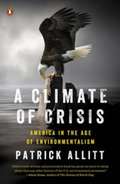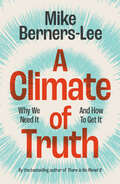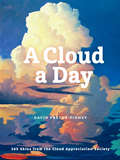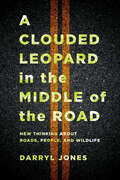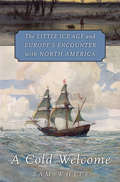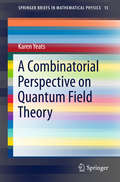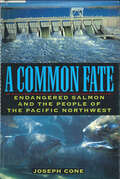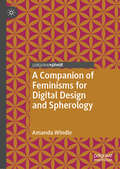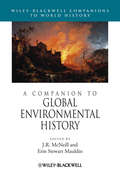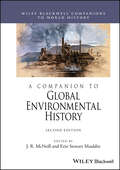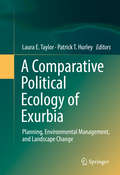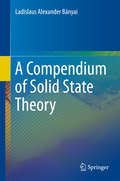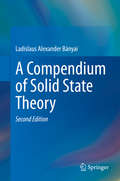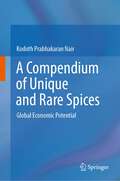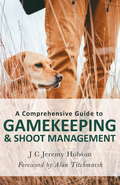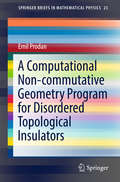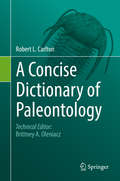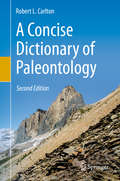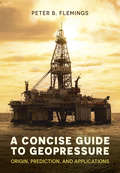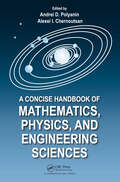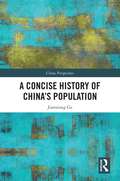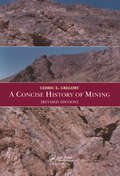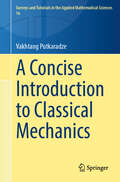- Table View
- List View
A Climate of Crisis
by Patrick AllittA provocative history of the environmental movement in America, showing how this rise to political and social prominence produced a culture of alarmism that has often distorted the facts Few issues today excite more passion or alarm than the specter of climate change. In A Climate of Crisis, historian Patrick Allitt shows that our present climate of crisis is far from exceptional. Indeed, the environmental debates of the last half century are defined by exaggeration and fearmongering from all sides, often at the expense of the facts. In a real sense, Allitt shows us, collective anxiety about widespread environmental danger began with the atomic bomb. As postwar suburbanization transformed the American landscape, more research and better tools for measurement began to reveal the consequences of economic success. A climate of anxiety became a climate of alarm, often at odds with reality. the sixties generation transformed environmentalism from a set of special interests into a mass movement. by the first Earth Day in 1970, journalists and politicians alike were urging major initiatives to remedy environmental harm. In fact, the work of the new Environmental Protection Agency and a series of clean air and water acts from a responsive Congress inaugurated a largely successful cleanup. Political polarization around environmental questions after 1980 had consequences that we still feel today. Since then, the general polarization of American politics has mirrored that of environmental politics, as pro-environmentalists and their critics attribute to one another the worst possible motives. Environmentalists see their critics as greedy special interest groups that show no conscience as they plunder the earth while skeptics see their adversaries as enemies of economic growth whose plans stifle initiative under an avalanche of bureaucratic regulation. There may be a germ of truth in both views, but more than a germ of falsehood too. America's worst environmental problems have proven to be manageable; the regulations and cleanups of the last sixty years have often worked, and science and technology have continued to improve industrial efficiency. Our present situation is serious, argues Allitt, but it is far from hopeless. Sweeping and provocative, A Climate of Crisis challenges our basic assumptions about the environment, no matter where we fall along the spectrum--reminding us that the answers to our most pressing questions are sometimes found in understanding the past.
A Climate of Crisis: America in the Age of Environmentalism
by Patrick AllittA provocative history of the environmental movement in America, showing how this rise to political and social prominence produced a culture of alarmism that has often distorted the factsFew issues today excite more passion or alarm than the specter of climate change. In A Climate of Crisis, historian Patrick Allitt shows that our present climate of crisis is far from exceptional. Indeed, the environmental debates of the last half century are defined by exaggeration and fearmongering from all sides, often at the expense of the facts. In a real sense, Allitt shows us, collective anxiety about widespread environmental danger began with the atomic bomb. As postwar suburbanization transformed the American landscape, more research and better tools for measurement began to reveal the consequences of economic success. A climate of anxiety became a climate of alarm, often at odds with reality. The sixties generation transformed environmentalism from a set of special interests into a mass movement. By the first Earth Day in 1970, journalists and politicians alike were urging major initiatives to remedy environmental harm. In fact, the work of the new Environmental Protection Agency and a series of clean air and water acts from a responsive Congress inaugurated a largely successful cleanup. Political polarization around environmental questions after 1980 had consequences that we still feel today. Since then, the general polarization of American politics has mirrored that of environmental politics, as pro-environmentalists and their critics attribute to one another the worst possible motives. Environmentalists see their critics as greedy special interest groups that show no conscience as they plunder the earth while skeptics see their adversaries as enemies of economic growth whose plans stifle initiative under an avalanche of bureaucratic regulation. There may be a germ of truth in both views, but more than a germ of falsehood too. America’s worst environmental problems have proven to be manageable; the regulations and cleanups of the last sixty years have often worked, and science and technology have continued to improve industrial efficiency. Our present situation is serious, argues Allitt, but it is far from hopeless. Sweeping and provocative, A Climate of Crisis challenges our basic assumptions about the environment, no matter where we fall along the spectrum—reminding us that the answers to our most pressing questions are sometimes found in understanding the past.From the Trade Paperback edition.
A Climate of Truth: Why We Need It and How To Get It
by Mike Berners-LeeWe have most of the technology we need to combat the climate crisis - and most people want to see more action. But after three decades of climate COPs, we are accelerating into a polycrisis of climate, food security, biodiversity, pollution, inequality, and more. What, exactly, has been holding us back? Mike Berners-Lee looks at the challenge from new angles. He stands further back to gain perspective; he digs deeper under the surface to see the root causes; he joins up every element of the challenge; and he learns lessons from our failures of the past. He spells out why, if humanity is to thrive in the future, the most critical step is to raise standards of honesty in our politics, our media, and our businesses. Anyone asking 'what can each of us do right now to help?' will find inspiration in this practical and important book.
A Cloud a Day: 365 Skies from the Cloud Appreciation Society
by Gavin Pretor-Pinney&“[A] year&’s worth of everything from Cirrus fibratus to Cumulo-stratus . . . reminds us that self-care is as available as a glance out the window.&” —The New York Times (Holiday Gift Pick) Cloudspotter and bestselling author Gavin Pretor-Pinney delivers a moment of calm atmospheric contemplation to members of his Cloud Appreciation Society by sharing a cloud image and story every day. A Cloud a Day urges all of us to keep our heads in the clouds with 365 fascinating formations from his extraordinarily popular Cloud Appreciation Society collection. Inspirational quotes and informative cloud facts accompany provocative and meditative images of the sky, encouraging readers to pause for a moment and look up. A beautifully illustrated book, A Cloud a Day makes a wonderful gift for dedicated or erstwhile cloudspotters—as for any of us with our heads lost in them. &“In his introduction, Pretor-Pinney explains that we live upon an ocean of gasses, and that it would improve the quality of our lives to spend a bit of time noticing that ever-changing ocean around us. After perusing this enlightening book, many readers will agree.&” —BookPage &“This meditative book gives you a daily dose of quotes, facts, and of course, clouds. Perfect for someone who you&’d like to encourage to look up, or whose head is in the clouds most of the time anyway.&” —Read Now Sleep Later &“If you&’re not interested in the science, the book will endear itself to you for the photographs, paintings, and prints it contains.&” —The Backroom
A Clouded Leopard in the Middle of the Road: New Thinking about Roads, People, and Wildlife
by Darryl JonesA Clouded Leopard in the Middle of the Road is an eye-opening introduction to the ecological impacts of roads. Drawing on over ten years of active engagement in the field of road ecology, Darryl Jones sheds light on the challenges roads pose to wildlife—and the solutions taken to address them. One of the most ubiquitous indicators of human activity, roads typically promise development and prosperity. Yet they carry with them the threat of disruption to both human and animal lives. Jones surveys the myriad, innovative ways stakeholders across the world have sought to reduce animal-vehicle collisions and minimize road-crossing risks for wildlife, including efforts undertaken at the famed fauna overpasses of Banff National Park, the Singapore Eco-Link, "tunnels of love" in the Australian Alps, and others. Along the way, he acquaints readers with concepts and research in road ecology, describing the field's origins and future directions. Engaging and accessible, A Clouded Leopard in the Middle of the Road brings to the foreground an often-overlooked facet of humanity's footprint on earth.
A Cold Welcome: The Little Ice Age and Europe’s Encounter with North America
by Sam WhiteWhen Europeans arrived in North America, the average global temperature had dropped to lows unseen in millennia and its effects—famine, starvation, desperation, and violence—were stark among colonists unprepared to fend for themselves. This history of the Little Ice Age in North America reminds us of the risks of a changing and unfamiliar climate.
A Combinatorial Perspective on Quantum Field Theory (SpringerBriefs in Mathematical Physics #15)
by Karen YeatsThis book explores combinatorial problems and insights in quantum field theory. It is not comprehensive, but rather takes a tour, shaped by the author's biases, through some of the important ways that a combinatorial perspective can be brought to bear on quantum field theory. Among the outcomes are both physical insights and interesting mathematics. The book begins by thinking of perturbative expansions as kinds of generating functions and then introduces renormalization Hopf algebras. The remainder is broken into two parts. The first part looks at Dyson-Schwinger equations, stepping gradually from the purely combinatorial to the more physical. The second part looks at Feynman graphs and their periods. The flavour of the book will appeal to mathematicians with a combinatorics background as well as mathematical physicists and other mathematicians.
A Common Fate: Endangered Salmon and the People of the Pacific Northwest
by Joseph ConeThough life on earth is the history of dynamic interactions between living things and their surroundings, certain powerful groups would have us believe that nature exists only for our convenience. One consequence of such thinking is the apparent fate of the Pacific salmon--a key resource and preeminent symbol of America's wildlife--which is today threatened with extinction. Drawing on abundant data from natural science, Pacific coast culture, and a long association with key individuals on all sides of the issue, Joseph Cone's A Common Fate employs a clear narrative voice to tell the human and natural history of an environmental crisis in its final chapter.As inevitable as the November rains, countless millions of wild salmon returned from the ocean to spawn in the streams of their birth. In the wake of an orgy of dam building and habitat destruction, the salmon's majestic abundance has been reduced to a fleeting shadow. Neglect is the word the author uses to describe more recent losses, "by exactly the ones--state and federal fish managers--who should have acted."To signal a new awareness that action is needed, scientists charged with restocking the Columbia River Basin are receiving significant support, while ordinary citizens are beginning to recognize the relationship between cheap power and the absences of chinook, coho, sockeye, and other species from the coasts of Oregon and Washington and from Idaho's Snake River. As desperate as the salmon's future appears, the book is not an elegy for a lost resource. Instead, it bears witness to hope. In addition to concrete plans for the wild salmon's renewal, the reader will hear a growing chorus of informed individuals of differing values and beliefs who recognize that our fate is inextricably bound to the salmon's; for many it is a new understanding.
A Companion of Feminisms for Digital Design and Spherology
by Amanda Windle<p>This book questions if spherology is a philosophy for designers, giving guidance on ways to read Spheres, how to approach the trilogy’s indexicality, and apply the key tropes and ethics of atmospheres to digital design. Each chapter includes a design-in, that is a practical entry point into the many tropes of Spheres including― bubbles, globes and foam. The book also applies spherology to an atmosphere design issue involving endangered species and geospatial threats to the environment. <p>Spherology refers to the Spheres trilogy by the philosopher Peter Sloterdijk, which traces spherical ideas, theories, sensations and feelings related to the philosophical concept of ‘being’ and the human-centered position of ‘being-in’. It is the first cynical, feminist companion of spherology to take a practice-led approach and to cover all three controversial volumes to with and against Spheres. Windle draws on feminist science and technology studies (STS) through parody within reading, writing and design practices. Design provides navigation so that academics and students can engage with spherology through an embodied concern with digital materiality. <p>As a feminist companion for today’s design issues, the book is an essential read for feminist STS scholars, design practitioners and digital R&D specialists working both in industry and academia, including more specifically data visualisers, interface and interaction designers.</p>
A Companion to Global Environmental History (Wiley Blackwell Companions to World History)
by J. R. McNeill Erin Stewart MauldinThe Companion to Global Environmental History offers multiple points of entry into the history and historiography of this dynamic and fast-growing field, to provide an essential road map to past developments, current controversies, and future developments for specialists and newcomers alike. Combines temporal, geographic, thematic and contextual approaches from prehistory to the present day Explores environmental thought and action around the world, to give readers a cultural, intellectual and political context for engagement with the environment in modern times Brings together environmental historians from around the world, including scholars from South Africa, Brazil, Germany, and China
A Companion to Global Environmental History (Wiley Blackwell Companions to World History)
by J. R. McNeill Erin Stewart MauldinA COMPANION TO GLOBAL ENVIRONMENTAL HISTORY Equips both specialists and newcomers with the historical, intellectual, and political context for engagement with the environment Providing multiple points of entry into a dynamic, fast-growing field, A Companion to Global Environmental History explores the many contours of the relationship between human societies and the natural world on which they depend. Bringing together essays by an international roster of both established experts and emerging scholars, this volume covers a uniquely broad range of temporal, geographic, thematic, and contextual approaches to the practice of global environmental history. Thirty-three detailed chapters describe how the relationship between society and nature has changed over time, examine the various drivers of change and environmental transformations, survey different types of environmental thought and action around the world, and more. Now in its second edition, the Companion is fully revised to reflect major research developments and new trajectories within the field. Updated chapters that present new evidence for longstanding debates and innovative applications of environmental history are accompanied by six entirely new chapters on India, China, Africa, early modern cities, global environmental governance, and European environmentalism. Offering fresh insights into environmental thought, culture, policy, and politics, A Companion to Global Environmental History, Second Edition, is an ideal textbook for undergraduate and graduate students and an invaluable reference for scholars, researchers, and environmental historians.
A Comparative Political Ecology of Exurbia: Planning, Environmental Management, and Landscape Change
by Laura E. Taylor Patrick T. HurleyThis book is about politics and planning outside of cities, where urban political economy and planning theories do not account for the resilience of places that are no longer rural and where local communities work hard to keep from ever becoming urban. By examining exurbia as a type of place that is no longer simply rural or only tied to the economies of global resources (e. g. , mining, forestry, and agriculture), we explore how changing landscapes are planned and designed not to be urban, that is, to look, function, and feel different from cities and suburbs in spite of new home development and real estate speculation. The book's authors contend that exurbia is defined by the persistence of rural economies, the conservation of rural character, and protection of natural ecological systems, all of which are critical components of the contentious local politics that seek to limit growth. Comparative political ecology is used as an organizing concept throughout the book to describe the nature of exurban areas in the U. S. and Australia, although exurbs are common to many countries. The essays each describe distinctive case studies, with each chapter using the key concepts of competing rural capitalisms and uneven environmental management to describe the politics of exurban change. This systematic analysis makes the processes of exurban change easier to see and understand. Based on these case studies, seven characteristics of exurban places are identified: rural character, access, local economic change, ideologies of nature, changes in land management, coalition-building, and land-use planning. This book will be of interest to those who study planning, conservation, and land development issues, especially in areas of high natural amenity or environmental value. There is no political ecology book quite like this--neither one solely focused on cases from the developed world (in this case the United States and Australia), nor one that specifically harnesses different case studies from multiple areas to develop a central organizing perspective of landscape change.
A Compendium of Solid State Theory
by Ladislaus Alexander BányaiDesigned to sit alongside more conventional established condensed matter physics textbooks, this compact volume offers a concise presentation of the principles of solid state theory, ideal for advanced students and researchers requiring an overview or a quick refresher on a specific topic.The book starts from the one-electron theory of solid state physics, moving through electron-electron interaction and many-body approximation schemes, to lattice oscillations and their interactions with electrons. Subsequent chapters discuss transport theory and optical properties, phase transitions and some properties of low-dimensional semiconductors. Throughout the text, mathematical proofs are often only sketched, and the final chapter of the book reviews some of the key concepts and formulae used in theoretical physics.Aimed primarily at graduate and advanced undergraduate students taking courses on condensed matter theory, the book serves as a study guide to reinforce concepts learned through conventional solid state texts. Researchers and lecturers will also find it a useful resource as a concise set of notes on fundamental topics.
A Compendium of Solid State Theory
by Ladislaus Alexander BányaiDesigned to sit alongside more conventional established condensed matter physics textbooks, this compact volume offers a concise presentation of the principles of solid state theory, ideal for advanced students and researchers requiring an overview or a quick refresher on a specific topic.The book starts from the one-electron theory of solid state physics, moving through electron-electron interaction and many-body approximation schemes, to lattice oscillations and their interactions with electrons. Subsequent chapters discuss transport theory and optical properties, phase transitions and some properties of low-dimensional semiconductors. This extensively expanded second edition includes new material on adiabatic perturbation theory, kinetic coefficients, the Nyquist theorem, Bose condensation, and the field-theoretical approach to non-relativistic quantum electrodynamics. Throughout the text, mathematical proofs are often only sketched, and the final chapter of the book reviews some of the key concepts and formulae used in theoretical physics.Aimed primarily at graduate and advanced undergraduate students taking courses on condensed matter theory, the book serves as a study guide to reinforce concepts learned through conventional solid state texts. Researchers and lecturers will also find it a useful resource as a concise set of notes on fundamental topics.
A Compendium of Unique and Rare Spices: Global Economic Potential
by Kodoth Prabhakaran NairThis book is a compendium of rare and unique spices, which have been least researched but hold immense economic potential on a global scale. They are Aniseed, Shallot, Saffron, Caraway or Siah Zira, European or Indian Dill, Poppy, Star Anise and Japanese Star Anise, Sage, Savory, Tarragon, Thyme, Calamus or Sweet Flag, Horse Radish, Galangal, and Long Pepper or Pipli. Some of these are seed spices and others, like Saffron, are grown in the hills of Jammu and Srinagar, India and have varied uses, ranging from being very popular food flavorants to being used for religious purposes. Even within India, the country of the origin for most of the spices listed, many Indians are simply unaware of their immense economic potential. This is also the case with other countries, like Iran, where some spices, like Saffron, is widely used as a food flavorant. The book aims to be a unique compendium of these rare and unique spices to primarily enable researchers to tap into their great economic potential and, on a wider scale, help developmental agencies to tap into their immense potential in global spice trade. The book provides a cross-sectoral multi-scale assessment of developmental possibilities, globally, for rare and unique spices of immense economic importance.
A Comprehensive Guide to Gamekeeping & Shoot Management
by J.C. Jeremy HobsonThis book shows the reader how to perform all the tasks required of the modern gamekeeper, including how to rear and release game, and advises on many aspects of habitat improvement and conservation. It also covers important and sometimes controversial issues, such as public access on private land, the need for predator and pest control, and many other aspects which need to be considered by keepers, be they part-time or professional.
A Comprehensive Guide to Gamekeeping & Shoot Management
by J.C. Jeremy HobsonThis book shows the reader how to perform all the tasks required of the modern gamekeeper, including how to rear and release game, and advises on many aspects of habitat improvement and conservation. It also covers important and sometimes controversial issues, such as public access on private land, the need for predator and pest control, and many other aspects which need to be considered by keepers, be they part-time or professional.
A Computational Non-commutative Geometry Program for Disordered Topological Insulators (SpringerBriefs in Mathematical Physics #23)
by Emil ProdanThis work presents a computational program based on the principles of non-commutative geometry and showcases several applications to topological insulators. Noncommutative geometry has been originally proposed by Jean Bellissard as a theoretical framework for the investigation of homogeneous condensed matter systems. Recently, this approach has been successfully applied to topological insulators, where it facilitated many rigorous results concerning the stability of the topological invariants against disorder. In the first part of the book the notion of a homogeneous material is introduced and the class of disordered crystals defined together with the classification table, which conjectures all topological phases from this class. The manuscript continues with a discussion of electrons' dynamics in disordered crystals and the theory of topological invariants in the presence of strong disorder is briefly reviewed. It is shown how all this can be captured in the language of noncommutative geometry using the concept of non-commutative Brillouin torus, and a list of known formulas for various physical response functions is presented. In the second part, auxiliary algebras are introduced and a canonical finite-volume approximation of the non-commutative Brillouin torus is developed. Explicit numerical algorithms for computing generic correlation functions are discussed. In the third part upper bounds on the numerical errors are derived and it is proved that the canonical-finite volume approximation converges extremely fast to the thermodynamic limit. Convergence tests and various applications concludes the presentation. The book is intended for graduate students and researchers in numerical and mathematical physics.
A Concise Dictionary of Paleontology
by Robert L. CarltonThis authored dictionary presents a unique glossary of paleontological terms, taxa, localities, and concepts, with focus on the most significant orders, genera, and species in terms of historical turning points such as mass extinctions. The book is an accurate and up-to-date collection of the most important paleontological terms and taxa, and may be used as a resource by students, researchers, libraries, and museums.Though useful to many in professional and academic settings, the book is also aimed at general readers of scientific literature who may enjoy the material without a background in paleontology. While there are many current resources on the subject, few fully encapsulate an accurate representation of the paleontological lexicon. This book attempts to compile such a representation in a moderately comprehensive manner, and includes a list of the most important monographs and articles that have been consulted to put together this essential work.
A Concise Dictionary of Paleontology: Second Edition
by Robert L. CarltonThis new and significantly updated authored dictionary is a unique glossary of paleontological terms, taxa, localities, and concepts. It focuses primarily on identifying the most significant groups of fossil animals and plants in relation to their evolution and phylogeny. It also focuses on mass extinctions, on taxa that are problematic in some significant way, on the principal fossil-Lagerstätten of the world, and on historical turning points marked by index fossils. Although there are many current resources on the subject, none contains an accurate representation of the paleontological lexicon. Although well aware that the fast-changing field of paleontology will always defy any attempt at complete description, the author has attempted to provide an accurate and comprehensive set of about 4,000 entries that will be useful to professionals as well as to general readers of scientific literature without a background in paleontology.
A Concise Guide to Geopressure: Origin, Prediction, and Applications
by Peter B. FlemingsGeopressure drives fluid flow and is important for hydrocarbon exploration, carbon sequestration, and designing safe and economical wells. This concise guide explores the origins of geopressure and presents a step-by-step approach to characterizing and predicting pressure and least principal stress in the subsurface. The book emphasizes how geology, and particularly the role of flow along permeable layers, drives the development and distribution of subsurface pressure and stress. Case studies, such as the Deepwater Horizon blowout, and laboratory experiments, are used throughout to demonstrate methods and applications. It succinctly discusses the role of elastoplastic behaviour, the full stress tensor, and diagenesis in pore pressure generation, and it presents workflows to predict pressure, stress, and hydrocarbon entrapment. It is an essential guide for academics and professional geoscientists and petroleum engineers interested in predicting pressure and stress, and understanding the role of geopressure in geological processes, well design, hydrocarbon entrapment, and carbon sequestration.
A Concise Handbook of Mathematics, Physics, and Engineering Sciences
by Andrei D. Polyanin Alexei ChernoutsanA Concise Handbook of Mathematics, Physics, and Engineering Sciences takes a practical approach to the basic notions, formulas, equations, problems, theorems, methods, and laws that most frequently occur in scientific and engineering applications and university education. The authors pay special attention to issues that many engineers and students
A Concise History of China’s Population (China Perspectives)
by Jianxiong GeThis book provides a comprehensive overview and explanation of China’s population, analyzing its special characteristics and patterns of growth over the past 2,000 years. Topics include its composition, distribution, migration, and deep analysis into China’s historical population. The author aims to answer complicated questions such as how China’s population was formed, when China started its earliest population surveys, how China’s population migrated and was distributed historically, and how existing population data should be evaluated and used now? In addition, the author explores the influence of natural and human-caused disasters, censuses, tax policies, and economic development on China’s population changes. The work also offers a span of rich historical detail related to population control. The book will be a great read to students and scholars of population studies, Chinese studies, ethnology, and those who are interested in Chinese history, archaeology, geography, and sociology.
A Concise History of Mining
by Cedric.E. GregoryA history of mining. This revised edition in a way describes the history of civilization and the early development of nations. Where minerals and mining existed, they provided ingredients for weapons, wealth and world power. The text should be useful in today's period of developing countries.
A Concise Introduction to Classical Mechanics (Surveys and Tutorials in the Applied Mathematical Sciences #16)
by Vakhtang PutkaradzeMechanics is one of the oldest and most foundational subjects in undergraduate curricula for mathematicians, physicists, and engineers. Traditionally taught through a classical, or "analytical," approach, modern advancements have introduced a "geometric" perspective that has found applications in diverse fields such as machine learning, climate research, satellite navigation, and more. This book bridges the gap between classical mechanics and its modern, geometric counterpart. Designed for students and educators, it presents the essential topics typically required in mechanics courses while integrating a geometric approach to deepen understanding. Key features include: *Clear explanations of core concepts, including Lagrangian mechanics, variational methods, canonical transformations, and systems with constraints. *Numerous solved problems and real-world examples to solidify understanding. *Sample midterms and final exams to help students prepare for coursework and assessments. *Every chapter includes a &‘looking forward&’ section outlining modern applications of the material. The book minimizes mathematical abstraction, introducing only the necessary concepts to make the material accessible and practical. Whether you're a student looking to master the essentials or an instructor seeking a fresh perspective, this book provides a comprehensive, approachable, and modern exploration of mechanics.
